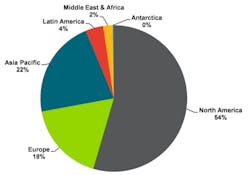With more microgrids comes the need for more microgrid O&M (operations and maintenance) services. Navigant Research’s Peter Asmus describes the growing market opportunity for these services.
Peter Asmus, Navigant Research
Navigant Research’s past market forecasts have focused on investments into the microgrid development value chain. This spending on the actual implementation of microgrid projects flowed to a diverse value chain of suppliers, technology providers, integrators, controls software vendors, and utilities. The forecasts captured the value of the assets as well as of the products and services that help to create a microgrid in the first place. As this fleet of microgrids worldwide grows over time, some vendors eye the ongoing operations and maintenance (O&M) of these microgrids as an additional source of sustaining revenue.
The new Market Data: Microgrid O&M Revenue Opportunities report examines revenue opportunities that can be captured from the ongoing O&M of microgrids. While an equally diverse set of opportunities present themselves in this area of the microgrid ecosystem, clarity on the extent and nature of how best to capture these revenue streams remains clouded. Nevertheless, the report puts a spotlight on the types of O&M revenue opportunities that are the most lucrative and available to the widest array of potential market participants.
The conclusion? That revenue opportunities for fixed cost O&M are typically significantly greater than those for variable O&M—even for highly utilized generation assets with frequent asset dispatch that incur relatively high variable O&M costs.
As is the case with forecasting implementation spending attached to new microgrid capacity, the only way to develop a valid market forecast for fixed O&M is to collect costs attached to key underlying microgrid enabling technologies. Fixed equipment O&M revenue can differ immensely between high capital cost equipment with zero fuel (solar PV) and low capital cost assets with high fuel costs (diesel generator). Fuel costs are excluded from the O&M revenue opportunity forecasts. Fuel is typically provided by incumbent utilities or long-term fuel suppliers that are not part of the typical microgrid value chain community. Though fuel can represent a majority of the O&M expense, with a few exceptions (such as Ameresco), microgrid developers and integrators rarely see fuel supply as part of their core offering.
As a result, fixed O&M is essentially about limiting effects on moving parts. This is the most important factor in understanding the O&M revenue opportunity since microgrids can deploy multiple types of distributed energy resources within networks with wide ranges of scale. Nevertheless, the market for these fixed O&M services linked to individual components may also be limited, since they are typically provided by the vendor that sold the hardware in the first place.
Target Opportunity Should Be the Fixed Balance-of-Plant O&M
For reasons previously described, Navigant Research has determined that fixed balance-of-plant (BOP) O&M is the best open market opportunity available in the microgrid market. Here, too, the size of that opportunity varies widely. The scope of this potential revenue stream is linked to microgrid size, resource mix, business model, and systems integrator. In 2017, the fixed BOP O&M represents an estimated 69 percent of the O&M revenue opportunity; by 2026, that drops to 54 percent, which is still the largest market share for any single fixed O&M revenue opportunity.
While the methodology Navigant Research used to forecast present and future fixed O&M revenue starts with cost data per each class of asset, BOP data about the distribution of these assets within each market segment and each region of the world allows one to estimate opportunities globally. Unlike the annual implementation spending forecasts Navigant Research has performed traditionally, the size of the O&M market must take into account the cumulative installed base of capacity. Luckily, Navigant Research tracks identifiable operating capacity by both market segment and region in its Microgrid Deployment Tracker, most recently published in 4Q 2016. This data—while incomplete due to many vendors’ reluctance to provide specific project details—provides a good, although admittedly conservative, starting point for building out the fixed O&M revenue opportunities forecast.
Operational Microgrid Capacity Market Share by Region, World Markets: 4Q 2016
Source: Navigant Research. By virtue of having the largest installed base of microgrids, North America leads today’s world in fixed O&M opportunities with an estimated $412.3 million in annual revenue. That fixed O&M revenue amount is expected to increase to $1.6 billion annually by 2026, with a compound annual growth rate of 15.9 percent.
Microgrid Fixed O&M Revenue Opportunities by Region: 2017-2026
Source: Navigant Research
Conclusion: The Role of Business Models on Microgrid O&M Opportunities
Perhaps the most important factor in determining O&M revenue opportunities has nothing to do with technology. As a result, it is the most difficult attribute to quantify. It is the question of what business model should be deployed to bring the microgrid design into reality.
A survey of projects identified in the Navigant Research Microgrid Deployment Tracker with published online dates of 2015-2016 revealed some interesting results. If measured on the basis of microgrid capacity, the power purchase agreement model is the preferred path, representing 45 percent of the total identified installed microgrid capacity (excluding stationary base military microgrids) in North America. Owner financing (16 percent) and utility rate base (15 percent) followed. Almost a quarter of the projects (24 percent) failed to provide data on what business model was deployed, or deployed a different business model not identified in the survey.
The rate-basing of microgrids by utilities can be paradoxical when it comes to O&M revenue opportunities. On the one hand, rate-basing tends to provide a disincentive for innovation, since all costs are essentially passed through to ratepayers. On the other hand, rate-basing can also provide enough head-room for robust O&M. Since utilities are often held to a higher performance standard than third-party infrastructure projects, this could lead to relatively robust O&M programs. From a market vantage point, rate-basing models may limit third-party vendors from accessing potential O&M service delivery pathways. The exception is if a utility outsources the O&M for microgrids.
Perhaps the simplest value proposition is the owner financing business model. The host and operator are one and the same under the simple version of this business model (In fact, the owner of the assets may outsource the O&M). However, the incentive under this approach is to have as little O&M risk exposure as possible. Though the incentive is to be prudent and avoid risks that could lead to a major equipment failure under a microgrid funded by the owner, it also implies a conservative technology mix that an onsite energy manager feels comfortable with. Most owner-financed microgrids lean toward the institutional/campus segment, and often focus on combined heat and power.
Peter Asmus is a principal research analyst contributing to Navigant Research’s Energy Technologies program.







